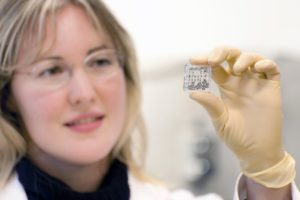Bespoke reference electrode for electrochemical sensors

Reference electrodes are fundamental to electrochemical sensors of all kinds. The most popular reference electrode is the silver/silver chloride electrode, widely used in pH meters and disposable sensor strips. They suffer from lifetime issues, leakage driven contamination, instability of potential and fragility.
Oxford researchers have applied their expertise and developed a novel solid state electrolyte-free reference electrode. Among the numerous advantages, the new technology makes the miniaturisation of the electrode feasible, opening a number of opportunities in the field of chemical sensing and analytical devices including the micro- and nano-scales.
The use of reference electrodes
High quality reference electrodes, are essential in all electrochemical experiments embracing both amperometric and potentiometric. They are fundamental units in the many chemical sensors which rely on such electrochemical measurements including glucose sensors and fire alarms.
The stability and robustness of a reference electrodes is key for its success as they dictate the sensitivity and longevity of a sensors.
The most popular reference electrode is the silver/silver chloride electrode. This is widely used in pH meters and often the reference electrode of choice in redox potential measurements as well as in a numerous biosensors including those built on screen printed electrodes. For a stable and reproducible potential, a fixed chloride concentration is crucial and this is achieved by having a Ag/AgCl surface in contact with a solution of potassium chloride of a fixed molarity inside or bathing the electrode.
Such requirements are often problematic in applications in which the reference electrode needs to be miniaturised or when the reference electrode is used in flowing solutions. Losses of AgCl from the electrode surface are well known and are the cause of contamination, potential drift, and loss of electrode stability. Alternatives are needed to drive forward and facilitate the highly active area of (electro-) chemical sensing.
Nafion film based reference electrodes
Researchers at Oxford have addressed these limitations through a bespoke design and developed a solid state electrolyte-free reference electrode in which the two components of a redox couple are uniquely immobilised on a Nafion film supported on a metal surface.
Advantages of this novel technology include:
- Simple fabrication
- Deployable on any metal surface
- Readily miniaturised
- Avoids leaching or continuation problems
- Excellent stability and lifetime
- Disposable
In summary, the doped Nafion film based reference electrode is a robust alternative to the silver/silver chloride reference electrode. Miniaturisation would allow for applications in analytical devices at all scales, as well as in disposable sensors.
Commercialisation
Oxford University Innovation has filed a priority patent application on the technology and welcome discussion with companies interested in licensing it for commercial development.
about this technology

